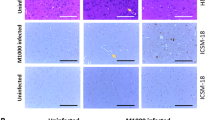Abstract
Prion diseases or transmissible spongiform encephalopathies are disorders of the central nervous system that affect both humans and animals. The underlying cause of prion diseases is the formation and propagation of the infectious prion protein. Prion diseases are difficult to diagnose and treat due to a prolonged asymptomatic incubation period prior to the onset of clinical symptoms. MicroRNAs (miRNAs) are small noncoding RNA species and have been identified as potential biomarkers that also function to regulate disease-specific pathways and proteins in several neurodegenerative disorders, including prion diseases. Here we describe the quantitative analysis of miRNA isolated from neuronal cells infected with a strain of mouse-adapted human prions. These methods can also be adapted to the discovery of miRNA biomarkers in extracellular vesicles, tissue, and noninvasive biological fluids.
Access this chapter
Tax calculation will be finalised at checkout
Purchases are for personal use only
Similar content being viewed by others
References
Prusiner SB (1982) Novel proteinaceous infectious particles cause scrapie. Science 216:136–144
Aguzzi A, Heikenwalder M (2006) Pathogenesis of prion diseases: current status and future outlook. Nat Rev Microbiol 4:765–775
Saborio GP, Permanne B, Soto C (2001) Sensitive detection of pathological prion protein by cyclic amplification of protein misfolding. Nature 411:810–813
Atarashi R, Satoh K, Sano K et al (2011) Ultrasensitive human prion detection in cerebrospinal fluid by real-time quaking-induced conversion. Nat Med 17:175–178
Lacroux C, Comoy E, Moudjou M et al (2014) Preclinical detection of variant CJD and BSE prions in blood. PLoS Pathog 10:e1004202
Edgeworth JA, Farmer M, Sicilia A et al (2011) Detection of prion infection in variant Creutzfeldt-Jakob disease: a blood-based assay. Lancet 377:487–493
Esteller M (2011) Non-coding RNAs in human disease. Nat Rev Genet 12:861–874
Dimmeler S, Nicotera P (2013) MicroRNAs in age-related diseases. EMBO Mol Med 5:180–190
Bartel DP (2004) MicroRNAs: genomics, biogenesis, mechanism, and function. Cell 116:281–297
Croce CM, Calin GA (2005) miRNAs, cancer, and stem cell division. Cell 122:6–7
Cao X, Yeo G, Muotri AR et al (2006) Noncoding RNAs in the mammalian central nervous system. Annu Rev Neurosci 29:77–103
Sempere LF, Freemantle S, Pitha-Rowe I et al (2004) Expression profiling of mammalian microRNAs uncovers a subset of brain-expressed microRNAs with possible roles in murine and human neuronal differentiation. Genome Biol 5:R13
Kosik KS (2006) The neuronal microRNA system. Nat Rev Neurosci 7:911–920
Schaefer A, O'carroll D, Tan CL et al (2007) Cerebellar neurodegeneration in the absence of microRNAs. J Exp Med 204:1553–1558
Kawase-Koga Y, Otaegi G, Sun T (2009) Different timings of Dicer deletion affect neurogenesis and gliogenesis in the developing mouse central nervous system. Dev Dyn 238:2800–2812
Huang T, Liu Y, Huang M et al (2010) Wnt1-cre-mediated conditional loss of Dicer results in malformation of the midbrain and cerebellum and failure of neural crest and dopaminergic differentiation in mice. J Mol Cell Biol 2:152–163
Bellingham SA, Guo BB, Coleman BM et al (2012) Exosomes: vehicles for the transfer of toxic proteins associated with neurodegenerative diseases? Front Physiol 3:124
Saba R, Goodman CD, Huzarewich RL et al (2008) A miRNA signature of prion induced neurodegeneration. PLoS One 3:e3652
Montag J, Hitt R, Opitz L et al (2009) Upregulation of miRNA hsa-miR-342-3p in experimental and idiopathic prion disease. Mol Neurodegener 4:36
Majer A, Medina SJ, Niu Y et al (2012) Early mechanisms of pathobiology are revealed by transcriptional temporal dynamics in hippocampal CA1 neurons of prion infected mice. PLoS Pathog 8:e1003002
Cohen E, Avrahami D, Frid K et al (2013) Snord 3A: a molecular marker and modulator of prion disease progression. PLoS One 8:e54433
Bellingham SA, Coleman BM, Hill AF (2012) Small RNA deep sequencing reveals a distinct miRNA signature released in exosomes from prion-infected neuronal cells. Nucleic Acids Res 40:10937–10949
Pfaffl MW (2001) A new mathematical model for relative quantification in real-time RT-PCR. Nucleic Acids Res 29:e45
Applied biosystems (2013) Procedure for multiplexing the RT step with or without preamplification while using TaqMan MicroRNA Assays In: Applied Biosystems User Bulliten 4465407. http://www.appliedbiosystems.com
Ibberson D, Benes V, Muckenthaler MU et al (2009) RNA degradation compromises the reliability of microRNA expression profiling. BMC Biotechnol 9:102
Wong L, Lee K, Russell I et al. (2007) Endogenous controls for real-time quantitation of miRNA using TaqMan® MicroRNA assays. In: Applied biosystems application note. http://www.appliedbiosystems.com
Author information
Authors and Affiliations
Corresponding author
Editor information
Editors and Affiliations
Rights and permissions
Copyright information
© 2017 Springer Science+Business Media LLC
About this protocol
Cite this protocol
Bellingham, S.A., Hill, A.F. (2017). Analysis of miRNA Signatures in Neurodegenerative Prion Disease. In: Lawson, V. (eds) Prions. Methods in Molecular Biology, vol 1658. Humana Press, New York, NY. https://doi.org/10.1007/978-1-4939-7244-9_6
Download citation
DOI: https://doi.org/10.1007/978-1-4939-7244-9_6
Published:
Publisher Name: Humana Press, New York, NY
Print ISBN: 978-1-4939-7242-5
Online ISBN: 978-1-4939-7244-9
eBook Packages: Springer Protocols




